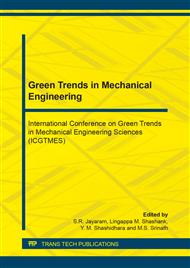[1]
Shaila Umair, Environmental impacts of fiber composites materials & study on life cycle assessment of materials used for ship super structure, Royal institute of technology, Stockholm, (2006).
Google Scholar
[2]
Amar, K Mohanty, Manjusri Misra, Lawrence Thaddeus Drzal.,Natural Fiber,Bioploymers, and Bio composites,,CRC press, Tailor and Francis, (2005).
Google Scholar
[3]
Gassan, J Bledzki, A.K, composites reinforced with cellulose based fibers,.journal of polymer science, vol 24,1999,pp.221-274.
Google Scholar
[4]
Wambua, Ivens and Verpoest,Natural fibers: can they Replace glass in Fiber Reinforcement Plastics",Composite Science Technology,63,2003,1259-1264.
DOI: 10.1016/s0266-3538(03)00096-4
Google Scholar
[5]
Singh, Agro- industrial wastes and their utilization,proceedings national seminar on building materials and their science and Technology, Roorke, vol 15,1982,p.111.
Google Scholar
[6]
Swamy, Development and study of natural fiber reinforced plastic composites",Research and Development report,UBDT (2004).
Google Scholar
[7]
Stamboulis,A." Effect of mechanical conditions on mechanical and physical properties of flax fibers, Composites, Applied science and Manufacturing, Vol 32, 2001, p.1105.
DOI: 10.1016/s1359-835x(01)00032-x
Google Scholar
[8]
Lilholt H. and J M lawther "Natural Organic Fibers, Fiber Reinforcements and General Theory of Composites, Elsevier, PP 303, (2000).
Google Scholar
[9]
Huang X, Netravali AN Biodegradable green composite made using bamboo micro/nano-fibrils and chemically modified soy protein resin. Compos Sci Technol, (2009) 69:1009–1025.
DOI: 10.1016/j.compscitech.2009.01.014
Google Scholar
[10]
Lee, Kim, Lee S, Kim HJ, Dorgan JR,Bio-composites of kenaf fibers inpolylactide: role of improved interfacial adhesion in the carding process. Compos Sci Technol, (2009) 69:2573–2579.
DOI: 10.1016/j.compscitech.2009.07.015
Google Scholar
[11]
Shih YF, Huang CC, Chen PW et al (2009) Biodegradable green composites reinforced by the fibre recycling from disposable chopsticks. Mater Sci Eng 527:1516–1521.
DOI: 10.1016/j.msea.2009.10.024
Google Scholar
[12]
Suryanegara L, Nakagaito AN, Yano H et al (2009) The effect of crystallization of PLA on the thermal and mechanical properties of microfibrillated cellulose-reinforced PLA composites. Compos Sci Technol 1187–1192.63.
DOI: 10.1016/j.compscitech.2009.02.022
Google Scholar
[13]
Netravali AN, Chabba S (2003) Composites get greener. Mater Today ,2966. Zhu H, Shen J, Feng X, Zhang H, Guo Y, Chen J et al (2010) Fabrication and characterization of bioactive silk fibroin/wollastonite composite scaffolds. Mater Sci Eng 30:132–140.
DOI: 10.1016/j.msec.2009.09.009
Google Scholar
[14]
Huang X, Netravali AN (2006) Characterization of Nano-clay reinforced phytagel modified soy protein concentrate. Biomacromolecules 7:2783–2789.
DOI: 10.1021/bm060604g
Google Scholar
[15]
Sabu T, Pothan. Cellulose fibre reinforced polymer composites. Philadelphie: Old City Publishing; (2009).
Google Scholar
[16]
Hill, Abdul Khalil. Effect of fiber treatments on mechanical properties of coir or oil palm fiber reinforced polyester composites. J Appl Polym Sci 2000;78:1685–97.
DOI: 10.1002/1097-4628(20001128)78:9<1685::aid-app150>3.0.co;2-u
Google Scholar
[17]
Alireza Ashori, Wood–plastic composites as promising green-composites for automotive industries! (H) science direct Bioresource Technology 99 (2008) 4661–4667.
DOI: 10.1016/j.biortech.2007.09.043
Google Scholar
[18]
Xiaosong Huang , Anil Netravali, Biodegradable green composites made using bamboo micro/nano-fibrils and chemically modified soy protein resin (I) Fiber Science Program, Cornell University , Composites Science and Technology 69 (2009) 1009–1015 (2009).
DOI: 10.1016/j.compscitech.2009.01.014
Google Scholar
[19]
Deepa et al., Structure, morphology and thermal characteristics of banana nano fibers obtained by steam explosion, Bioresource Technology 102 (2011) 1988–(1997).
DOI: 10.1016/j.biortech.2010.09.030
Google Scholar
[20]
A. C. H. Barreto et al., Chemically Modified Banana Fiber: Structure, Dielectrical Properties and Biodegradability, J Polym Environ (2010) 18:523–531.
DOI: 10.1007/s10924-010-0216-x
Google Scholar


